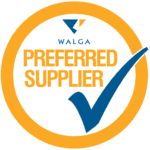Navigating the complexity of road signs and driver behaviour requires a deep dive into psychology, cognitive science, and design. This article uncovers the rationale behind road sign design and the profound impact it has on driving.
As industry leaders in Australia, Corsign crafts road signs that successfully communicate critical information to drivers, playing a vital role in promoting road safety. View our products here.
Colour, contrast, and the human brain
The spectrum of colours visible in road signs is far from random; each colour is purposefully selected and carries an internationally standardised message. For example, red, a colour that psychologically triggers alertness, often signifies danger or a call to stop. The yellow signs, resonating with caution and attention, are usually used to signal potential hazards on the road. Green, associated with notions of safety and permission, suggests direction or signals the presence of a permitted act. Lastly, blue often provides information about services or features, such as parking zones or hospitals.
Contrast is another crucial aspect of road sign design. High contrast between a sign’s foreground and its background is vital for optimising visibility and readability. For instance, the ‘stop’ sign uses a bright red background contrasted by bold white text. This contrast is easily visible from a distance, thereby granting drivers ample time to react even in conditions of compromised visibility such as dusk, dawn, or poor weather.
Shape and size: more than meets the eye
One of the key elements that contribute to the effectiveness of road signs is their shape. The shape of a sign is not just an aesthetic choice; it plays a crucial role in its recognition, even before the driver is close enough to read any symbols or text that it contains. Ultimately, the shape of a road sign serves as the first layer of communication to the driver.
In the realm of road sign design, specific shapes have been universally accepted to represent certain categories of information.
- Octagonal: The eight-sided figure is used exclusively for ‘stop’ signs. Its unique shape, which is different from the majority of other road signs, makes it instantly recognisable. This quick recognition is vital, considering that a failure to observe the ‘stop’ sign could lead to significant road safety issues.
- Circle: Circular signs typically deliver regulatory instructions or prohibitions. Most speed limit signs fall into this category, represented as black numbers within a red circle. A driver recognising the circular shape will instantly be aware that the sign contains regulatory information, allowing them to prepare for possible changes in their driving behaviour.
- Triangle: Triangular signs, with one point facing downwards, are universally used for warning alerts. These could range from alerts about road conditions, such as bends or intersections, to warnings about pedestrian crossings or animal crossings. The triangular shape serves as an immediate alert to the driver to be prepared for potential hazards.
- Rectangle: Rectangular signs are generally used for informational purposes. These signs may provide directions, and distances, or feature supplementary plates to enhance the comprehension of other signs (like the distance over which a warning or regulatory sign applies).
Size, similar to shape, is also a strategic design decision in road signs, corresponding to both the sign’s importance and the speed of the approaching traffic.
- Importance: Critical signs that demand immediate action from the driver, such as ‘stop’ or ‘give way’, are deliberately designed to be larger. The increased size of these signs makes them more noticeable and ensures that they command the attention of the driver. This is crucial to prevent accidents and maintain road safety.
- Speed: The speed at which drivers approach a sign can significantly impact their ability to process the information it conveys. To account for this, larger signs are typically used in high-speed areas like highways or motorways. The larger size gives drivers more time to recognise the sign, read and understand its message, and take the necessary action. In contrast, in areas with lower speed limits, such as residential zones or city streets, signs can afford to be smaller as drivers have more time to react.
Furthermore, the height at which signs are installed is also carefully considered. They are usually installed at a height where they are clearly visible to drivers, taking into account factors like speed, proximity, road type, and the presence of any potential obstructions.
The minimalistic approach: symbols over text
Road signs require drivers to process and act upon the presented information almost instantaneously. To facilitate quick understanding, designers often resort to universally recognised symbols and minimal text. For instance, pedestrian crossings are indicated by an easy-to-understand graphic of a person walking, negating the need for complex textual explanations.
This design choice leverages the human brain’s propensity for processing visual information quicker than textual data. By relying on symbols, road signs cater to a diverse demographic of drivers, transcending barriers of language and literacy.
The psychology of compliance and social proof
The psychology of driver compliance with road signs hinges on two fundamental principles: social proof and fear of punishment.
Social proof, or informational social influence, suggests that individuals often mirror the actions of others when uncertain. Drivers, for instance, are more likely to follow road signs if they observe others doing the same. This herd mentality is particularly noticeable in unfamiliar areas, where drivers depend on the actions of locals to navigate the road rules. Witnessing non-compliance can also influence drivers to disregard traffic rules, highlighting the importance of visible, law-abiding behaviour.
The fear of punishment acts as a counterbalance to social proof. It capitalises on the principle of negative reinforcement, which deters individuals from undertaking an action to avoid unpleasant outcomes like fines or penalties. Enforcement measures such as speed or red light cameras illustrate this concept. Road signs announcing their presence serve as powerful reminders of the consequences of rule-breaking, thereby prompting drivers to adhere to traffic rules.
In effect, road signs play a dual role—they provide information and leverage psychological principles to influence behaviour. By understanding these principles, we can design road signs and associated enforcement strategies that enhance compliance and improve road safety.
Consistency and familiarity: ease of cognitive processing
Consistency in road sign design and implementation is key to a comprehensible and safe driving environment. Following the Australian Road Rules, Western Australia maintains a standardised set of signs statewide, providing a familiar landscape for locals, interstate travellers, and overseas visitors alike.
This uniformity goes beyond mere aesthetics and practicality; it has significant psychological implications. Familiar signs allow for automatic cognitive processing, where the brain instantly recognises and interprets the sign without conscious thought. This swift understanding saves comprehensible effort, which can then be allocated to other critical driving tasks, like observing road conditions and controlling the vehicle.
By maintaining a consistent signage system, Western Australia’s Department of Transport enhances the efficiency of the driving environment, contributing to overall road safety. This exhibits how the design and positioning of road signs are more than mere traffic regulation instruments. They’re tools based on cognitive science and human behaviour understanding, underlining the intricate psychology behind road signs.
Sign placement and anticipated hazard perception
The strategic placement of road signs is another significant aspect that leverages drivers’ psychological perceptions. Warning signs are usually positioned sufficiently ahead of the impending hazard, offering drivers ample time to comprehend and respond appropriately. The distance between the sign and the hazard is calculated based on the average speed of the traffic, providing a reasonable response time.
Corsign: enhancing road safety through quality signage
As we delve deeper into the psychology behind road signs and how design influences driver behaviour, it’s essential to acknowledge the role of companies that produce these vital safety tools. One such company deserving recognition is Corsign—we’re an Australian-owned and operated enterprise specialising in manufacturing high-quality road signs.
Corsign understands the significant role that signage plays in road safety and driver behaviour. Our dedicated team adheres to the guidelines laid out in the Australian Road Rules, ensuring that our products maintain the consistency critical for automatic cognitive processing and efficient driver response.
Whether it’s regulatory signs, warning signs, or guide signs, Corsign ensures they are recognisable, easily interpretable, and suitable for various environmental conditions. Our products are crafted to withstand Australia’s diverse weather conditions, offering longevity and continued visibility even in the harshest circumstances.
What sets Corsign apart, however, is our commitment to customisation. Recognising that specific regions or situations may call for unique signs, we offer tailored solutions to meet unique requirements. This includes signage for mining or construction sites, which are often subject to different conditions and regulations.
Corsign is more than just a signage manufacturer; we are a pivotal partner in road safety. Our understanding of the principles discussed in this article—the need for consistency, clear symbolism, and effective psychological triggers—underpins our commitment to producing signs that not only meet regulatory standards but effectively guide and protect road users.
With Corsign, you’re not merely investing in a piece of metal or plastic; you’re investing in safety, psychological savviness, and a company dedicated to enhancing the road experience for all users. Whether you’re a local government entity, a private company, or a construction firm, choosing Corsign ensures you’re contributing to a safer and more efficient driving environment. Get in touch today and have a chat with our team about your needs.




